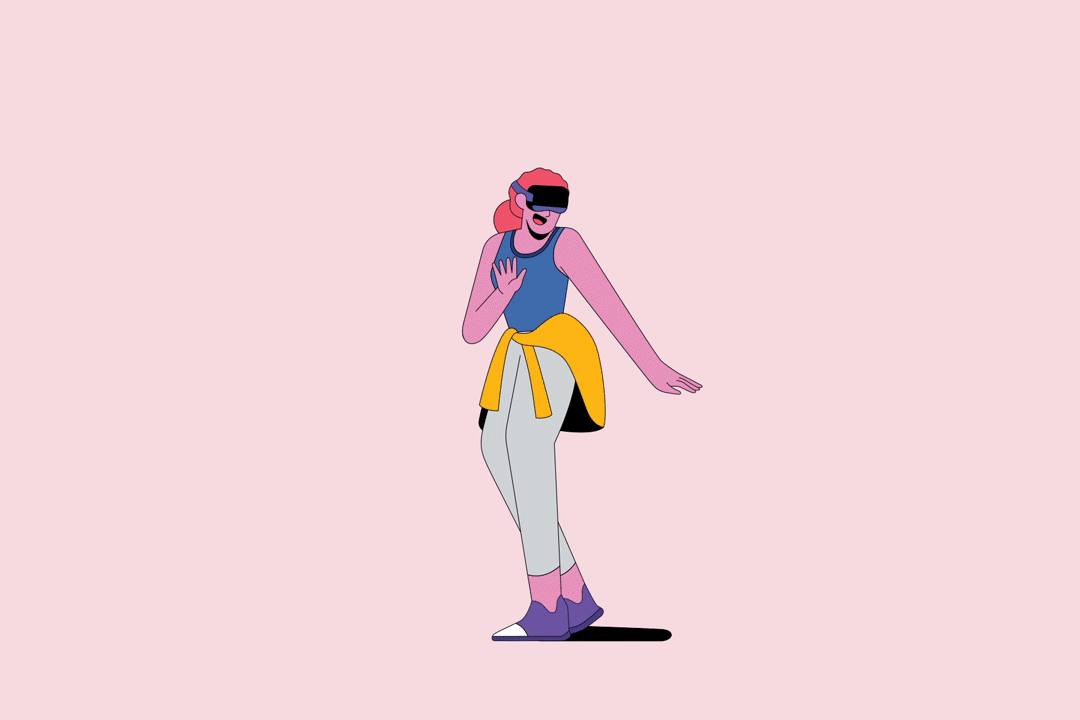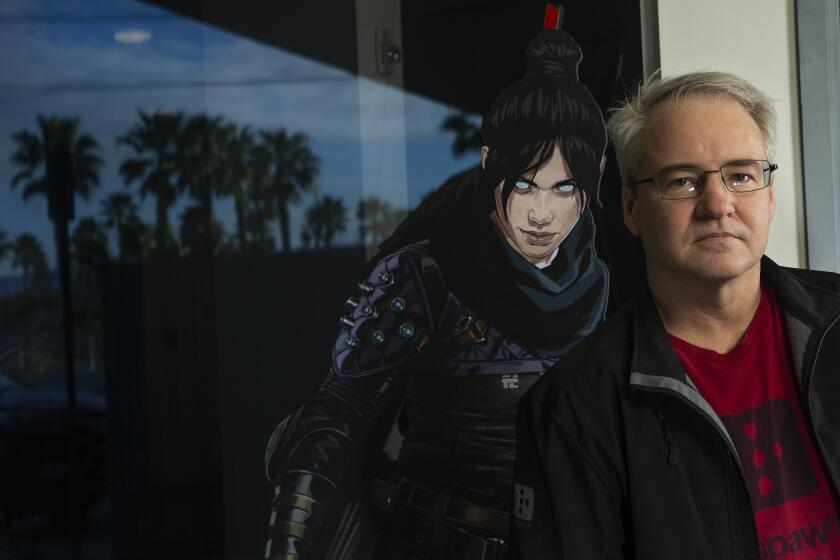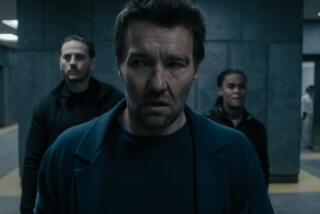
All it took to make me a believer of virtual reality was for reality to break.
This was the thought I had after about 45 minutes inside my VR headset on a Monday afternoon. I had barely moved. A forest surrounded me. A bird sat perched on a tree branch. My hand held a video game controller. But what I saw was a futuristic airbrush, a laser-like paint sprayer that looked like a prop from a 1940s sci-fi film.
A touch of a button and I could color the world. The bird before me was purple. Then it was pink. Then blue. Then pink again. I shot the feathered creature with random color as if I were Flora, Fauna and Merryweather all in one, toying with the chroma of the universe as if I alone possessed the power of the fairy godmothers of âSleeping Beauty.â
Soon the alarm on my smartphone sounded. This was my cue to remove the VR headset and flip on the radio to listen to another sobering address from Mayor Eric Garcetti. I sat and stared as L.A.âs mayor spoke, my eyes tracing a scratch on my coffee table. Illuminated by the late afternoon sun, the wear had long escaped my vision. Having spent the day in a heightened version of reality, I was suddenly more attuned to my very real, very dusty surroundings. The enchanted world of âColor Spaceâ seemed very far away.
During the first few weeks under stay-at-home orders, I tried to get re-acquainted with my apartment. When Iâd chase my cat and lie around with her, I pretended to view furniture as she might, as blocky skyscrapers.
I was trying to turn my home into a playing field, and that helped (and is still helping) ease my anxiety. But I must be honest with myself. I am not in a good place emotionally. I view everything that lies outside my door â be it the mailbox on the first floor of my 12-story apartment complex or the recycling bins at the end of the hall â as places to fear.
Home, in this headspace, is not a place to play; itâs a place to hide out, at least until the pandemic comes to an end â or a declining market leads to an eviction. Which comes first right now feels like something of a tossup. My home is no longer comforting.
In this moment, I found virtual reality. And, to be sure, I had been skeptical.
Burned one too many times by the promise of a virtual reality revolution, Iâve seen a lot of works that felt more like tech demos than rich experiences. And though I love many animated VR shorts that have emerged, Iâve found that often their charms can be enjoyed without a restrictive headset.
Beyond the technology or the cost, the underlying question that has plagued many VR experiences is simple: Why are you asking me to put a thing on my head? Too often, the answer is no deeper than,âbecause itâs more immersive.â
As the technology matured, another important question has emerged: How will this virtual reality world respond to me â and create the illusion of recognizing me?
Itâs not that I donât enjoy being transported to an all-encompassing virtual world that allows for 360-degree views; I am simply taken out of the experience if my being there is not acknowledged. Think of it as an awareness on the part of product that Iâm not just a player or a viewer but something more akin to an actor. I am stepping into a world to play, and the less the world recognizes my appearance in it, the less patience I have for spending time in it.
âThe difference is the feeling of presence, says VR industry veteran Jesse Schell, whose Schell Games had an early VR success story with the escape room-inspired âI Expect You to Die.â
âIf I film two people sitting at a table and make a movie out of it,â Schell says, âthereâs two people and theyâre having a conversation and thatâs fine. If I make the same thing in VR, the participant is thinking, âWhy donât they notice me? Iâm right here. It seems weird that theyâre talking and donât know Iâm here.â Thatâs the fundamental difference, and everyone is starting to get that now.â
And so late on that Monday afternoon, I turned off the radio and longed for the rabbit hole. I picked up the headset and thatâs where I went.
A pet, in a virtual reality experience aptly named âDown the Rabbit Hole,â is lost. Inside the headset a universe of diorama-like rooms â settings familiar to anyone with a cursory knowledge of Lewis Carrollâs âAlice in Wonderlandâ â surround me.
Iâm not so much transported to another reality as I am journeying to a more innocent era, one filled with childlike wonder. Only now, I donât have to pretend a toy rabbit or a doll is alive; they move before me and with me, allowing me to guide them. Some moments I see the world from their point of view. Other times I pull their rooms toward me, or push them above me. Shifting the perspective has itself become a game, where a virtual vine can be turned to reveal a cozy bedroom.
I want to go there, even if the books on the shelves, designed for rabbits, are printed in no known language.
Games are a playground, a place to see what happens when we do what we arenât told, and a world in which failure is embraced â welcomed, even â as a way to learn. Why play matters in times of stress.
There have been other VR experiences Iâve enjoyed lately. âVader Immortal: A Star Wars VR Series,â a work from Lucasfilmâs ILMxLab, started game-like but gradually unfolded to feel more akin to immersive theater. Then there are location-based explorations concocted by Dreamscape, where the world-building is so exquisite that their 20- to 25-minute adventures forever feel too short, although itâs unknown when or if weâll get to visit them again.
Recently, and especially within the past year, experiences ranging from the theatrical âThe Under Presentsâ to the highly detailed puzzles of âThe Room VR: A Dark Matter,â or even the coloring book-inspired âColor Space,â show that virtual reality has started to reach its long-hyped promise.
Itâs been a gradual shift.
âMoss,â released in 2018, wasnât the first VR game to utilize run-and-jump platforming techniques. Yet the game, placing the player in the role of a sort of overseer of the world directing a sword-fighting mouse named Quill, was one of the first to reignite my interest in the medium after the hype that met the launch of the Oculus Rift and the PlayStation VR in 2016.
In âMoss,â Quill is aware of the playerâs response, at times communicating with and non-verbally asking for help. Dialogue early on implies we, as humans, have had some role in this fairy tale universe, creating an early mystery surrounding our presence in it.
These past few months alone have seen a number of major VR releases, with developers starting to push out more content for the stand-alone headset the Oculus Quest, a device that makes high-quality VR relatively accessible by operating divorced from a cord and without the need for a pricey computer.
Respawn Entertainment began with a mission to build a better shooter. That became the hit âTitanfall.â In 2019, the studio expanded with the free-to-play âApex Legendsâ and âStar Wars: Jedi Fallen Order.â The studio run by Vince Zampella is just getting started, with a virtual reality project on tap for 2020. Zampella also is taking over the Los Angeles offices of DICE.
âThe Room VR: A Dark Matterâ stands as the best solitary VR experience I have had, one that Iâve been saving and relishing, in part because its puzzles arenât obvious and in part because the world is built for contemplation.
âThe Room VR,â agrees Schell, is âone of the most elaborate VR experiences ever created.â Set in 1908 London, the gameâs urban world romanticizes the gloom of rain-soaked cobblestones. The only outdoors Iâve experienced in more than a month has been brief sits on my buildingâs fire escape, so I was happy to just chill on a London balcony listening to the trots of distant horses.
Simply booting âThe Roomâ creates a cozy, in-from-the-cold sensation, only the mystery that unfolds is a bit spooky and constantly toys with us. And yet it never does so in a jostling way (I avoid most thrillers and all things horror). Instead, the game invites us to interact with much of its environment and at times has us wear virtual glasses to illuminate a world-within-a-world. When utilizing this game mechanic, I am now two steps removed from the real world, making the virtual one feel even richer.
Of course, these brief respites from the real world arenât cheap. The headset that makes most sense to own is the Oculus Quest, which, if you can find it in stock, sells for either $400 or $500, depending on the storage size. The Quest has been hard to find since its release about a year ago, and the Facebook-owned company has stated production has been afffected by the current health crisis.
I should also note that I havenât mentioned the most talked-about VR game released this year, Valveâs âHalf-Life: Alyx.â I donât have the budget for a computer that can run it, and my simple-person laptop isnât going to cut it, even with an optional cord that can link with the Quest.
So even for someone relatively tech-inclined, VR wonât be fully within my grasp for the foreseeable future. Virtual reality, for now, belongs to the gaming 1%.
The Happiest Place on Earth shut its gates Friday night due to the coronavirus crisis. A full non-weather-related closure of Disneyland has happened just three times in the parkâs 65-year history. But this time is different.
But thereâs also no denying that we appear to be on the brink of some sort of VR breakthrough. Schell notes his companyâs games have seen a spike in sales since stay-at-home orders went into place, and though he concedes that VR isnât cheap, with personal finances likely to be wrecked even long after the pandemic ends, virtual reality for many may start to be a substitute for a vacation, or even that trip to a theme park.
Schell points to the success film had during the Great Depression, noting that, comparatively, it was a relatively decent value.
âI think what it really comes to down to is dollars per hour of value,â he says. âA game console is pricey at $399. Not everyone can afford it, but a lot of people can, and if you can get hundreds of thousands of hours of meaningful play out of it, then it can feel like a good value.â
And that says nothing of personal comfort levels. For myself, as long as going to get the mail causes me fear, Iâm going to need to go somewhere.
So right now, thereâs a talking mouse with a sword who needs me.
More to Read
The biggest entertainment stories
Get our big stories about Hollywood, film, television, music, arts, culture and more right in your inbox as soon as they publish.
You may occasionally receive promotional content from the Los Angeles Times.













